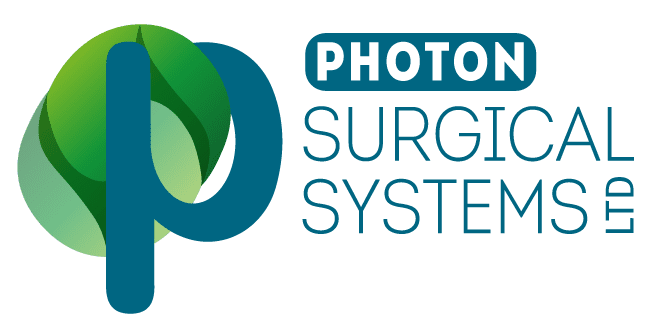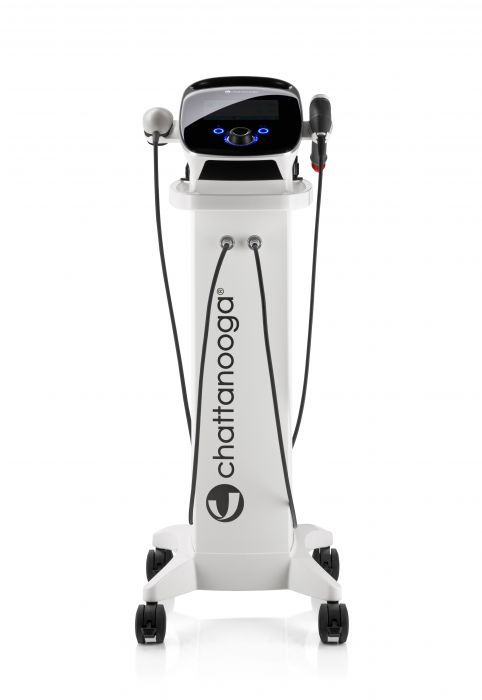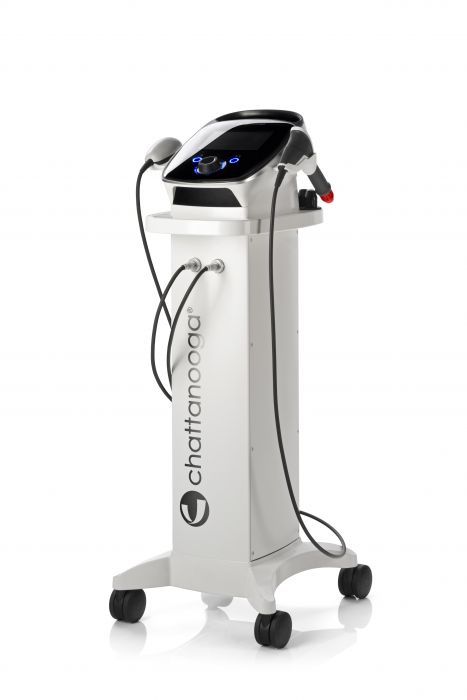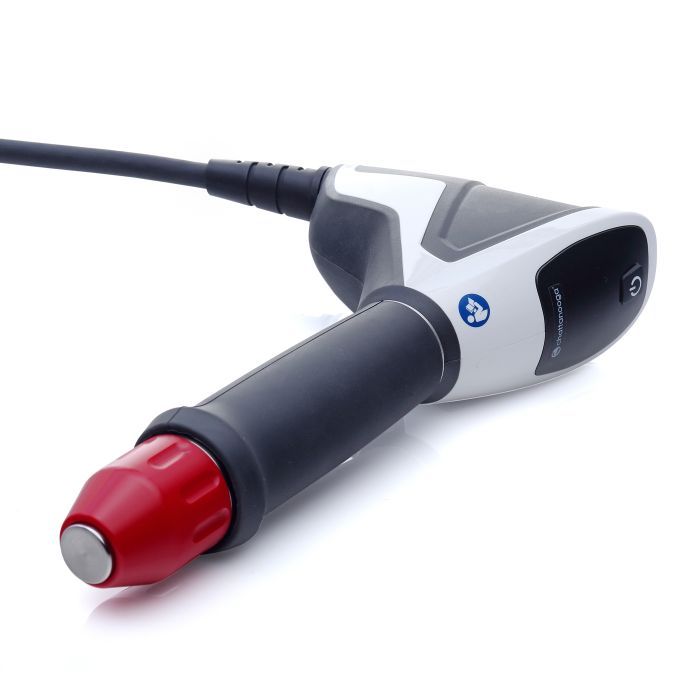Summary
- 2 advantages of the floor standing version are that it has a slightly bigger compressor and the machine has the facility for presets. (Notes. : Larger unit has more power by about 15-20% (bigger compressor), also has customisable presets. However, Vets doing ambulatory work needs the smaller unit. Smaller unit – 1-4 Bar pressure and 1-15 Hz frequency. Commonly use 8-12 Hz and 2.5-3.0-3.5 bar depending on the condition treated. 1500 –2000 shots per treatment.)
- Both systems use Storz hand-pieces, Storz manufacture high-quality projectiles.
- Warranty 3 years.
- The projectile/guide tube/transmitter head needs replacing every 1 million shots. So for a vet, this is likely to be every 3 years or so? It comes with a spare set so you are good to go for 2 million shots. These can be changed by the user and the cost of the parts is £230 + VAT
- Annual servicing is done on site. Cost £160 + Filter £65 + VAT.
The units are available on trial for 1 week, thereafter £200 + VAT per week hire charge (which is then deducted from the purchase price if you decide to keep it).
Product Description
Therapeutic shockwaves were introduced as a medical treatment for eliminating kidney stones without causing skin injury, over 20 years ago. Some of the side effects discovered while using this treatment were the bone healing and accelerated tissue healing results on the areas submitted to shockwave treatment. Today the use of radial shock waves or Radial Pressures Waves (RPW) has been successfully extended to other therapeutic and wellness applications such as- shoulder calcifications / insertional tendonitis/muscle trigger points/muscle and connective tissue activation/acupuncture therapy/cellulite treatment/body shaping / lymphatic drainage / medical massage.
Shockwave therapy is a non-invasive treatment; the probe is applied directly to the skin over the affected area. Due to the local sensation of slight discomfort and vibrations from the compressor, most patients are lightly sedated to minimise distress and for operator/equipment safety reasons. The treatment works in two ways; desensitisation of local nerve ends provides effective and quite prompt pain relief and reduction in muscle spasms, while also stimulating tissue healing by promoting blood flow to the affected area.
- Pain reduction: The patient experiences a reduction of pain, explained by the Gate Control theory. Intensive pulses from the transmitter into the tissue, create a strong nociceptor activation of the A-β fibres, which affect interneurons that inhibit the transmission of the pain signals.
- Increased metabolism:
Shockwaves influence the tissue on a cellular level. The chemical environment of the cells is affected by free radicals promoting the release of pain and inflammatory inhibiting substances. - Revascularisation:
Repeated shockwaves to the affected area create a revascularisation effect, with the new blood flow in the area promoting tissue healing and regeneration. Reduced muscle tone: The “vicious circle”, as well as the strong pathological association between pain and muscle tone, will be broken and lead to restoring a normalised muscular tone. - Radial Pressure Wave therapy is indicated for:
Myofascial Trigger Points (MTrP), Localising and deactivating trigger points, activation of muscle and connective tissue, increasing circulation, pulse vibration massage.
Disorder of tendon Insertions, plantar fasciitis, heel pain, or heel spur, tendinosis calcarea/supraspinatus-tendon. - Radial and ulnar humeral epicondylitis, achillodynia, retro patellar pain syndrome, tibial edge syndrome, proximal Iliotibial band friction syndrome/trochanteric, insertional tendonitis
The primary indications for its use in the equine population include:
- Primary back injuries: These include muscle and ligament strains and sprains, kissing spines (impinging dorsal spinous processes) and sacroiliac injuries.
- Back pain/muscle spasm secondary to primary lameness: Many horses with single or multiple limb lameness have pronounced muscle spasms along the back, particularly under and just behind the saddle. Any horse with back pain should be assessed by an experienced equine vet for evidence of mild lameness.
- Ligament injuries: The suspensory ligament is the most frequently injured and treated ligament, particularly injuries involving the top portion of the ligament where it attaches to the cannon bone just below the knee and hock (proximal suspensory desmitis). Forelimb suspensory ligaments and to a lesser extent hind limb injuries can respond well to treatment. We have also successfully treated damaged check ligaments, annular ligaments (fetlock), patellar ligaments (stifle) and collateral joint ligaments (mainly pastern and coffin joints).
- Tendon injuries: Injuries to the lower leg, primarily involving the superficial and deep digital flexor tendons are treated with shockwave therapy in a similar manner to ligament injuries. Improved quality of healing regarding the ultrasonographic appearance of the tendons can be seen, although a prolonged period of graduated exercise is still essential to minimise the risk of recurrence.
- Angular limb deformities in foals: Recent studies have found that shockwave treatment can be helpful in treating foals with abnormal bending of the limbs, either from birth or as an acquired condition during the first year of life. Limb deviations usually involve the growth plates close to the knee, hock and fetlock joints in the fore or hind limbs and can lead to permanent deformities if left untreated, preventing any form of athletic career. Treatment of the growth plate with shockwave therapy appears to slow down the rate of growth on the affected side of the leg, thereby allowing the other side of the limb to catch up. This treatment can be used in conjunction with remedial hoof trimming and special glue on shoes. We have treated several foals successfully over the last two stud seasons which would otherwise have required surgical correction of the deformities at considerably greater expense and risk to the foals.
The equipment is portable so treatment can be undertaken either a clinic or at home. An initial course involves three treatments, at fortnightly intervals, with each treatment taking around 10-20 minutes to complete, depending on how many or how large an area is involved. Depending on the response to treatment, some patients will have further individual sessions over the following months while undertaking a graduated exercise regime.
Product Features
- Full-colour LCD touch-screen interface
- State-of-the-art navigation features enable you to access the desired functions at the touch of a finger
- Treatment setup via Quick-link Indications, Clinical Protocols™ or manual adjustment
- 200 user-defined protocol storage slots
- Over 80 clinical protocols on board
- Clinical Resources include: – Full-colour graphics library of anatomical images and pathologies – Hand piece placement images – Radial pressure wave rationale – Radial pressure wave contraindications
- Two channels allow connection of 2 hand pieces
- Unique optimal energy level adjustment feature that allows gradual ramping of the intensity during treatment
- Convenient storage platform allows secure and easy access to hand pieces, transmitters and gel
- 360° swivel rotation of interface
- Large storage drawer for storage of clinical supplies
- Dimensions: 42cm x 41cm x 114.3cm
- Patient documentation of treatment sessions, pre and post treatment patient pain scales, pain mapping and pain types all captured on Patient Data Cards
- Warranty: Main unit 3 years, Handpiece 3million pulse or 1 year
Standard Accessories kit supplied with the unit:
- D-ACTOR® Hand piece applicator / Projectile (x2) / R15 15 mm ESWT transmitter / D20-S D-ACTOR® 20 mm transmitter / Sealing set / Guide tube (x2) / Cleaning brush / Conductor™ Transmission gel 250 ml / Patient data card (x1) / User manual on CD
Maintenance
- Annual service including serviceable parts – done on site.
- After 1 million shots needs a new barrel and bullet (For the average user this would be every 2-4 years.)
At PSS we pride ourselves on our customer service and are happy to offer as much help as needed regardless of the query size.
We have an ethos of providing the best quality products at affordable prices and fully supporting them with our own team of highly skilled and experienced technicians and engineers.
Our Price Promise:
We aim to offer the most competitive price, but if you can buy the same item elsewhere for a better price let us know and we will try to match or better the price.
Demos/Loans:
Picking equipment from a website can be quite a challenge. We can visit your practice, so you can sample our products and discuss your needs with one of our team.
How To Order:
You don’t have to pay now. Many of our customers have accounts open with us as they like to be invoiced later, instead of paying now.
You can order:
Online: You can order online and select the invoicing option that suits you
Email: info@photonsurgicalsystems.co.uk
Phone: 01452 347101
Backorders:
We keep most items in stock and will aim to despatch the next day to you. Pre-owned items will be serviced and checked prior to being shipped as quickly as we can to you. However, special-order items / made to order items may take up to 4 weeks. Once an order is placed a member of our team will be in contact to keep you informed of estimated delivery dates.
Related Products




